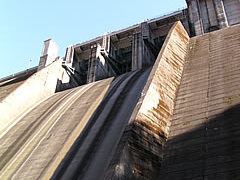 "ta" column or row of the kana syllabary
"ta" column or row of the kana syllabaryBank length
The crest length is the length of the dam embankment (top). In the case of a fill dam, the concrete portion of the flood discharge is not included, but the crest length tends to be longer than that of a gravity concrete dam or an arch dam.



